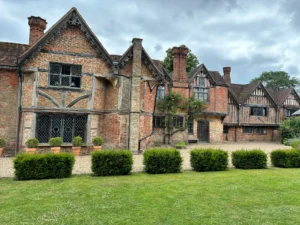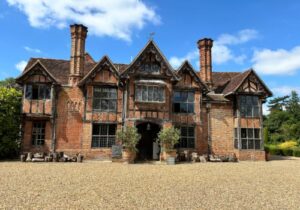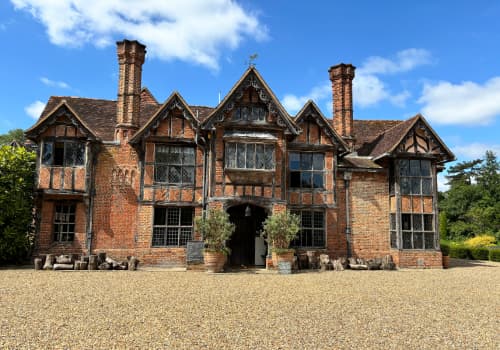Film Location for: The Fox & Goose Hotel in Midsomer Worthy („Strangler’s Wood“), Bantling Hall in Bantling Village („Bantling Boy“), Allenby House in Midsomer Parva („Secrets & Spies“), Pelfe Hall in Great Pelfe („Not in my Backyard“), manor of Lord Argo in Carver Valley (“Drawing Dead”)
Film location for Midsomer Murders
Dorney Court really is a historical gem. It’s not as grand as some manor houses that were built later, but I simply adore it. Built on the border of Buckinghamshire and Berkshire and near Eton and Windsor Castle, it has been a Grade 1 listed building on the National Heritage List since 23 September 1955.
The manor has so far been used as a filming location for four episodes of our beloved series, namely
- The Fox & Goose Hotel, Midsomer Worthy (S02E02: Strangler’s Wood)
- Bantling Hall, Bantling Village (S08E04: Bantling Boy)
- Allenby House, Midsomer Parva (S12E03: Secrets & Spies)
- Pelfe Hall, Great Pelfe (S13E07: Not in my Backyard)
- manor of Lord Argo (exterior und entry hall) (S20E03: Drawing Dead)
And, as always, let’s take a look at the history of the Dorney Court estate and its family, the Palmers. To do this, we have to go back quite far in English history. For there was a building here before Norman times.
The History of Dorney Court and its Owners

The back of Dorney Court. Photo by Petra Tabarelli, Public Domain
Dorney Court is intertwined with the history of England. I’m sure Honoria Lyddiard would have loved to have had it as the home of her family, who is woven in to the very warp and woof with the history of England. But I digress…
Before the present estate was built, back in Saxon times, there was an earlier building here which belonged to a certain Alread, a man of the Earl of Morcar, before 1086. This place was even inhabited in the 2nd millennium BC!
Miles Crispin is named as the owner in the Domesday Book. Over the next 500 years or so it passed through the Cave, Parker, Newnham, Paraunt, Carbonell, Scott, Restwold, Lytton, Bray, Hill families and finally, in 1537, Sir William Garrard, Lord Mayor of London. His daughter married Sir James Palmer of Wingham in Kent. For nearly 500 years the Early Tudor manor house has been the home to the Palmer family.
Dorney Court comes into the possession of the Palmer family
When Sir William Garrard died, the house passed to his wife Elizabeth and their son Thomas. However, there was a major family dispute: Thomas married Dorothy, daughter of Sir William Clarke of Hitcham, against her father’s wishes.
This led to a major family dispute, which resulted in Thomas renouncing his wife so that he could continue to live at Dorney Court. This in turn caused Dorothy’s family to despise him. There followed quarrels, lawsuits… the whole lot, I suppose.
Eventually – in 1624 – Thomas sold Dorney Court to his sister Martha, who by then had married James Palmer. More precisely, he sold to Richard Palmer, who was acting as a trustee for his relative.
Generations of the Palmer family
James Palmer was knighted five years later. Over the course of his life he also became Gentleman of the Bedchamber to James I and Charles I, Chancellor of the Order of the Garter, Governor of the Royal Tapestry Works, Mortlake, Adviser to the Royal Collection and a personal friend of Charles II.
He was also an artist and miniaturist and painted several portraits of James I, the Earl of Southampton and the Earl of Northampton.
A few decades later, Dorney Court passed from father to son Charles. And so it has been ever since: Dorney Court is passed down through thirteen generations as a family home.
The Interior & Exterior of the Historic House

The front of Dorney Court. Photo by Petra Tabarelli, Public Domain.
Dorney Court is one of England’s Finest Tudor Manor Houses. Situated in the west of London, it is near the Thames and also close to the church on the west side of the village. It is Grade I listed in the National Heritage List.
What about the architectural? Well, the house appears to be entirely Early Tudor, but part of the exterior is a Victorian reconstruction.
Early Tudor? Victorian reconstruction? But it looks early Tudor now… Everything is correct: the original building was completely out of date in the 18th century. That’s why it was rebuilt according to the tastes of the time. A few decades ago it was conservatively restored to its original state, partly using the original bricks.
The interior has changed very little since 1500. The panelled parlour is the oldest area and contains some fine antique furniture. The Great Hall is also worth a visit.
The 15th century stone fireplace is not in situ and the panelling is said to have come from Faversham Abbey. The original timber construction is visible in many places throughout the house, and many original features such as the fireplace, remain, while other old fittings have been brought from other houses.
Family Portrait after family portrait and their closest associates of the Palmer family can be seen in the rooms of the manor, especially in the Great Hall.
England’s First Pineapple and Other Disappointments
Did you know that the first pineapple in England was grown here, at Dorney Court? Roger Palmer, a diplomat and mathematician, managed to bring seeds of this exotic fruit to England and had them planted in his garden. Thanks to an excellent gardener, a pineapple palm actually grew there. Roger Palmer gave the first one to King Charles II in 1661, who was so taken with it that he hired Palmer’s gardener to be his royal gardener.
This was not the only person the King had wooed away from Roger Palmer, for only a year earlier Roger’s wife Barbara Villiers had been unfaithful to him and become a royal mistress. (After Roger and Barbara had only married in 1659).
- 1659 Marries Roger Palmer
- 1660 Mistress of King Charles II (still in exile in the Netherlands)
- 1661 Marriage to King Charles II
And 1662? Well, after Barbara had given birth to the first of her five children with Charles II, she separated from her new husband.
Barbara Villiers
Apparently a beautiful woman but with little dowry, Barbara knew how to make herself secure as a mistress. None of her lovers or husbands could be sure that the child was really theirs.
This included the king, for Barbara may no longer have been his wife, but she was once again his mistress.
Her ex-husband Roger was created Earl of Castlemaine and Baron Limerick by Charles II in 1661 to provide for his mistress and her children.
Barbara Villiers herself was created Duchess of Cleveland, Countess of Southampton and Baroness Nonsuch in 1670. At the same time, however, her influence at court began to wane. In the years that followed, the king increasingly turned to other mistresses. Barbara did the same, marrying several more times before dying of heart failure in 1709.
Visit Dorney Court
The Catholic family suffered during the Civil War. Their estates were confiscated in 1646. It is no coincidence that the parlour at Dorney Court still contains a priest hole, which is open to visitors.
Talking of tours: The estate is open to the public and tours have been possible at certain times of the year since 1981, as the family continues to live at the manor. In 2024 you could book a guided tour throughout June, for 2025 I am not aware of any times.
Visitors will find one of the most beautiful Tudor mansions in England and beautiful gardens. Afterwards you can then visit the Crocus at Dorney Court garden centre, tea room and shop.
The current visit and guide prices can be seen here.
It is often used as a film location. Most recently and most prominently for the successful series Bridgerton, but also several times for Midsomer Murders.
Read more about Midsomer Murders & History
The Chronology of Midsomer County by Year or by Episodes
Deep Dives into Midsomer & History
This is an independent, non-commercial project. I am not connected to Bentley Productions, ITV or the actors.

First published on MidsomerMurdersHistory.org on 4 October 2024.
Updated on 24 September 2025.


[…] the site of his home, Bantling Hall, is in Dorney, Buckinghamshire. The beautiful Tudor mansion, Dorney Court, has been on the National Heritage List since 23 September 1955 and stands on the site of a manor […]
[…] colonies in the War of Independence, although he was a soldier in the English army. The place, Dorney Court in Buckinghamshire, also belonged to the Palmer family, who were loyal to the King. However, there […]
[…] to Bantling Hall, located in the picturesque village of Dorney, Buckinghamshire… no, sorry: Dorney Court. A stunning Tudor manor that has been listed on the National Heritage List since 23 September 1955. […]
[…] Dorney Court, Dorney, Buckinghamshire […]
[…] Drehort für Bantling Hall, Dorney Court in Buckinghamshire, gehörte – wie die Hartleys – der königstreuen Familie der Palmer […]
[…] to Bantling Hall, located in the picturesque village of Dorney, Buckinghamshire… no, sorry: Dorney Court. A stunning Tudor manor that has been listed on the National Heritage List since 23 September 1955. […]
[…] Hall, befindet sich jedoch in Dorney, Buckinghamshire. Das wunderschöne Herrenhaus im Tudorstil, Dorney Court, steht seit dem 23. September 1955 auf der Liste des nationalen Kulturerbes und steht an der Stelle […]